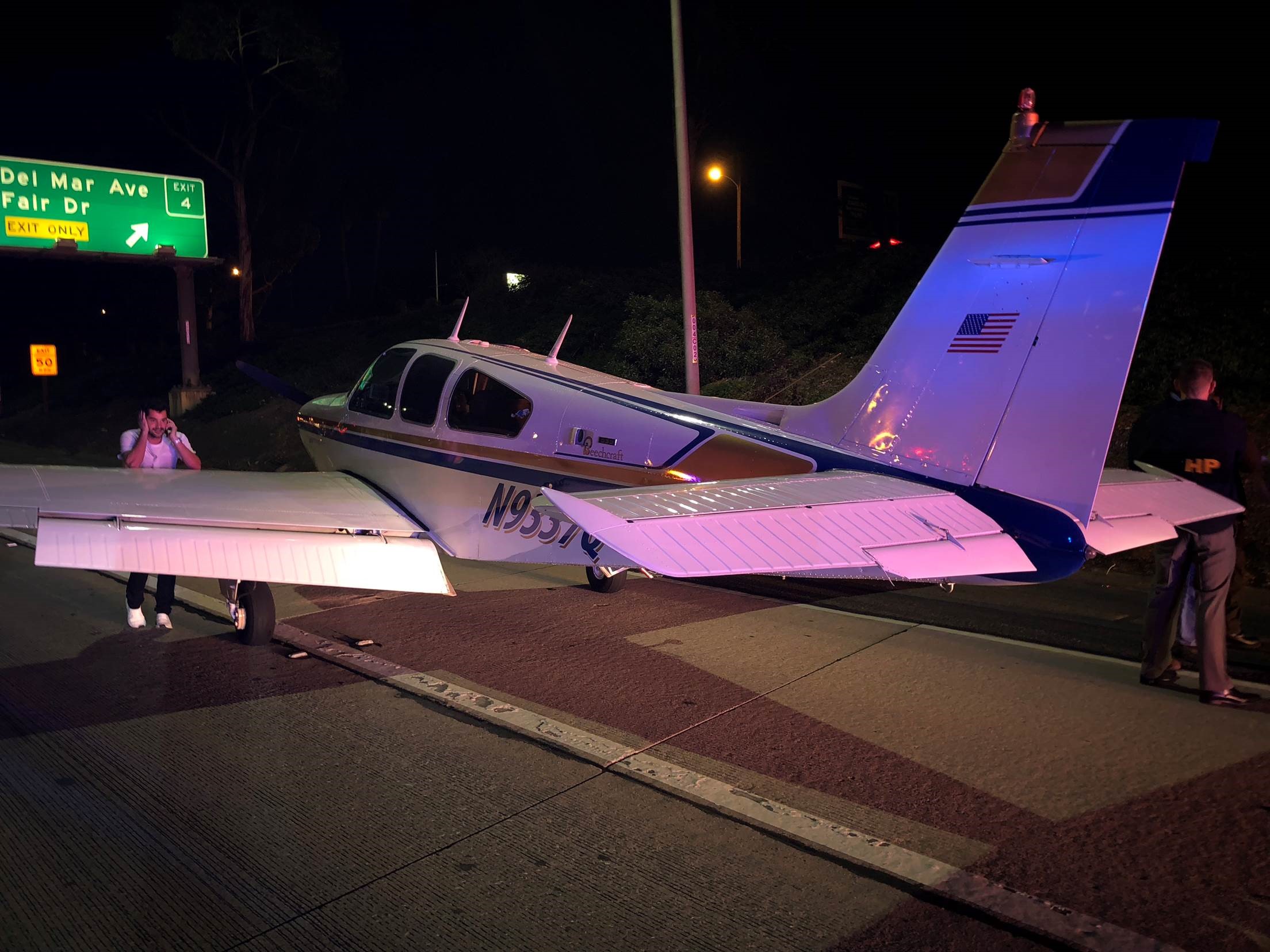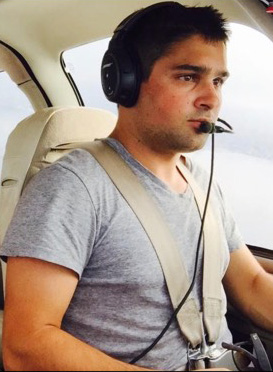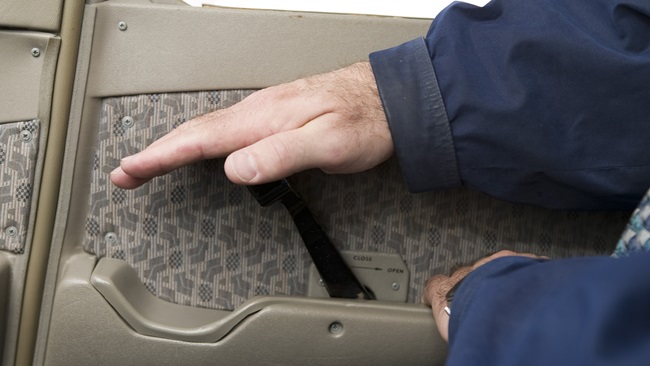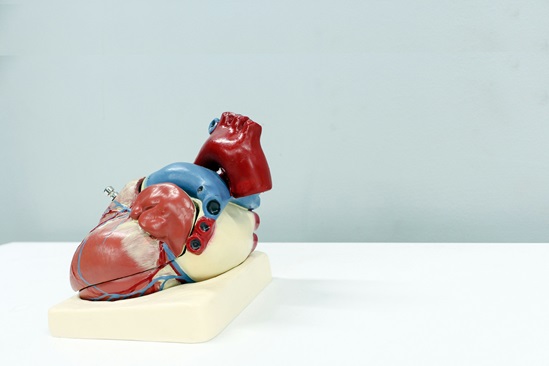Pilot recounts emergency night landing on busy freeway
An engine failure in a single-engine airplane over the ocean at night ended safely for the two occupants when the pilot abandoned his Plan A, to glide to an airport eight miles away, and improvised a Plan B, setting down on a busy California freeway by maneuvering beneath an overpass bristling with obstacles while his passenger trained a flashlight on the airspeed indicator.

Izzy Slodowitz, 23, and nonpilot passenger Daniel Gross were flying a 1971 Beechcraft G33 Bonanza from San Diego to Van Nuys, California, at 5,500 feet above the Pacific Ocean the night of Jan. 28 when the engine made a grinding noise and stopped.
Five miles offshore and eight miles from John Wayne Orange County Airport in Santa Ana, Slodowitz immediately turned toward the airport and declared an emergency.

He made seven or eight attempts to restart the engine, but the engine didn’t respond, the 2,000-hour commercial pilot, who flies a variety of piston and turboprop aircraft, told AOPA.
“It was almost like the key and the starter motor weren’t even attached,” he said.
By the time the airplane descended to about 2,000 feet msl, it was obvious to “Slod”—the name Slodowitz goes by online and gave to local news media—that the glide into strong Santa Ana headwinds was going to leave them short of the runway. He could see some “black-hole areas” in the densely populated region between his position and the airport, but he didn’t like the look of them.
That didn’t look any better, but something about the road seemed wrong: It had multiple lanes, but traffic seemed to be traveling in only one direction.
“I didn’t see any tail lights,” he said.
The southern California native knew that there were too many lanes down there for a one-way road—meaning that the opposite direction lanes were empty and available as an emergency runway.
Gliding down to a final approach, Slodowitz—who had had the presence of mind not to lower the electrically powered landing gear yet—now confronted an overpass spanning the road directly in front of him. Lacking the airspeed to pull up and over the obstruction, with its light poles and other obstacles, he flew under it, lowering the gear at the last second and rolling to a safe stop on State Route 55 near the Del Mar exit.
In an interview two days later, Slodowitz, who is a University of Southern California Marshall School of Business student and army veteran who flies commercially when he is not studying, said he still felt shaken from the incident. He was still “piecing things together” but was willing to share some early impressions with fellow pilots.
The Bonanza, owned by two friends including an aviation mechanic, had given no indications of trouble earlier in the day, when he and Gross had flown from Van Nuys Airport to San Diego to attend a charity event. One possibility, based on a phone conversation with the FAA, was that the crankshaft had failed, because the prop could not be moved by hand during an inspection after the incident. That might be consistent with the grinding noise the engine made just before it “stopped and froze,” he said.
‘Procedures and training’
Slodowitz has been around airplanes since age 15, soloed at 16, and got his private pilot certificate on his seventeenth birthday. After three years in the Army, he added commercial pilot and airline transport pilot certificates. He has flown missions for the nonprofit Wings of Rescue organization, and his experience includes piloting piston aircraft, including various Cirrus single-engine airplanes, and single-engine Pilatus PC-12 and twin-engine Beech King Air turboprops.
During the glide toward John Wayne Orange County Airport, he recalls being “very, very calm, just focused on procedures and training.”
But uncertainty set in when he realized the airport was out of reach.
“I couldn’t envision an outcome when I’d walk away from it,” he said, adding, “In my mind it was almost like a bad dream.”
Then the highway “opened up” before him and he performed his freeway landing, hailed as a miracle in extensive local media coverage featuring views of the Bonanza stopped on the busy freeway, emergency responders on the scene, and traffic on the freeway squeezing by in unblocked lanes. The California Highway Patrol coordinated removal of the airplane from the roadway—an operation that consisted of loading the Bonanza onto a flatbed tow truck and hauling it to the Orange County Fairgrounds, said Fire Captain Chris Coates of Costa Mesa Fire and Rescue.
Before the airplane had stopped rolling, he said, he began to laugh in relief at the realization that he and Gross would walk away unscathed from the event. Controllers at John Wayne Orange County Airport shared their relief the next morning when Slodowitz called them to say thanks for their assistance.
Despite some social-media reactions sent his way since the incident, Slodowitz remains unshaken in his belief that general aviation is “incredibly safe.”
He wants to take advantage of the media attention to use the event as a learning tool, and promote aviation safety by sharing his insights about emergency training and the realities of in-flight emergencies—an idea he broached with SCU Marshall's dean, James G. Ellis, who got in touch to offer well wishes on hearing about the freeway landing.
Slodowitz wonders, for example, whether pilots who practice simulated off-airport landings to a field or other clear area during training absorb the true implications of the exercise.
A real-world emergency requires “really looking at that field,” and examining it for obstructions such as telephone poles that could prevent you from getting there; knowing the wind direction could also be a determining factor in a successful outcome.
“Having a good answer for your flight instructor or examiner, and really doing it is very different,” he said.
Then there’s the “going with the gut” factor. “Once I realized I wasn’t going to make the airport, there was no more training there,” he said. Slodowitz had to make quick decisions, such as whether to turn left or right after ruling out continuing the glide toward those black hole areas near the airport.
He’s not sure why he turned left, but he’s glad he did.
Remember the mnemonic, “Aviate, navigate, communicate”?
After notifying ATC that his engine had quit, Slodowitz ignored several calls from the tower as he attempted several times to restart the engine. When he did re-establish contact, he requested the wind speed and direction at the airport—crucial information for a power-off landing. (He would learn later that when he began gliding toward the airport from cruise altitude, he was bucking a headwind of almost 30 knots based on ATC’s readout of a 50-knot groundspeed. The wind was lighter at lower altitude, he said.)
System knowledge played its part: Slodowitz realized that the attempts to restart the engine had imposed a serious drain on the aircraft battery, which would be needed to power the extension of the G33’s electrically powered landing gear.
So he shut down the battery to “save the juice for the last second,” and continued his glide with his passenger shining a cellphone’s flashlight on the airspeed indicator.
When the instant came to lower the gear, “I put the battery on, saw three green (lights), put the gear and the flaps down, completely out of muscle memory, instinct, and training,” he said.
What-if scenarios
He recalls reminding himself during the glide that the Bonanza is a piston-powered airplane with a draggy non-feathering constant-speed propeller, unlike turboprops with props that go to a low-drag, fully feathered position.
Since the emergency, Slodowitz has had time to ponder hypothetical scenarios such as what he would have done if he had been flying a ballistic-parachute-equipped Cirrus when the emergency occurred. Perhaps he would have continued toward the black holes and then deployed the chute, he speculates.
One thing is certain about that scenario: “When I realized I wasn’t going to make it, I have zero doubt in my mind I would have pulled the chute,” he said.
Slodowitz credits training, good fortune, and “too many variables” to count in helping him and Gross survive a night landing on a busy highway on which a gap in the traffic flow appeared just when he needed it, leaving him room to maneuver under an obstruction, and more.
“I even moved the plane to the side of the road,” he said.



